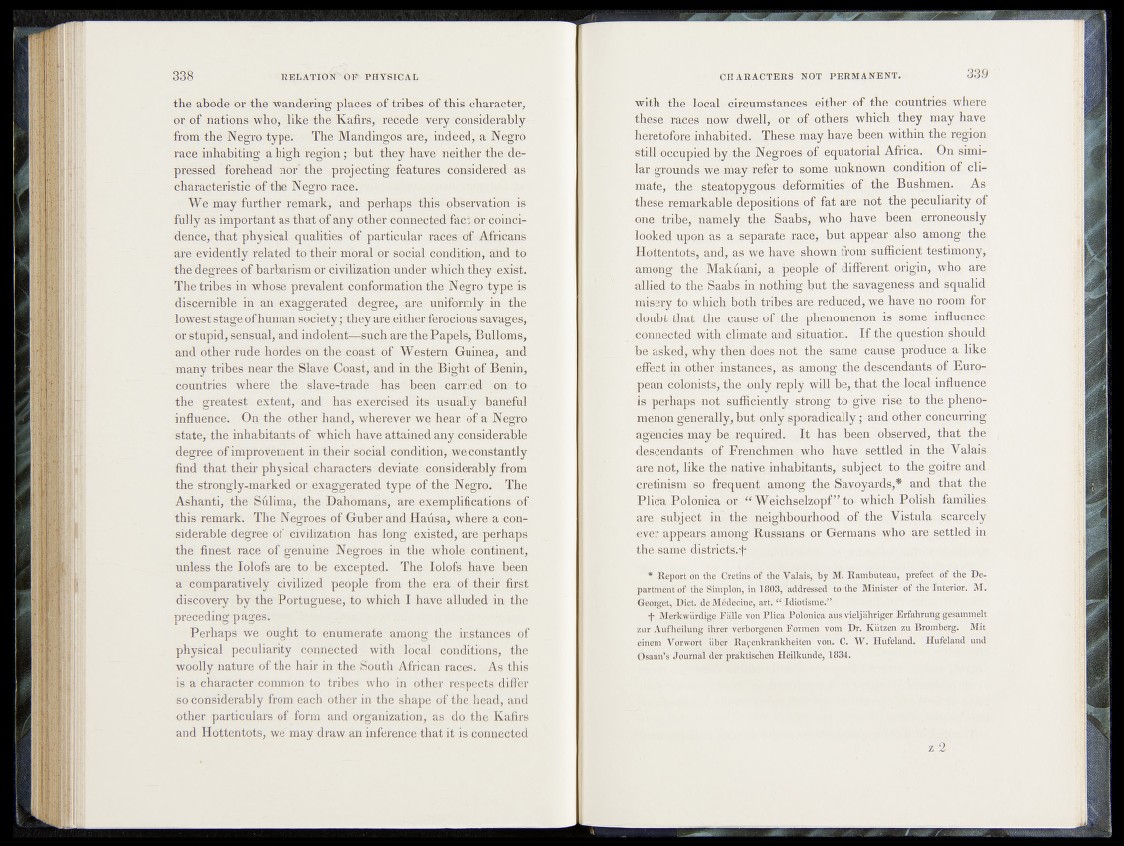
the abode or the wandering places of tribes of this character,
or of nations who, like the Kafirs, recede very considerably
from the Negro type. The Mandingos are, indeed, a Negro
race inhabiting a high region; but they have neither the depressed
forehead nor the projecting features considered as
characteristic of the Negro race.
We may further remark, and perhaps this observation is
fully as important as that of any other connected fact or coincidence/
that physical qualities of particular races of Africans
are evidently related to their moral or social condition,'Slid to
the'degrees of barbarism or civilization under which they exist.
The tribes in whose prevalent conformation thejNegro type is
discernible in an exaggerated degree, are uniformly in the
lowest stage of human society; they are.either ferocioussavages,
or stupid, sensual, and indolent—such are the Papels, Bulloms,
and other rude hordes on the coast of Western Guinea, and
many tribes near the Slave Coast, Und in the Bight of Benin,
countries where the slave-trade has been -carried on to
the greatest extent,'and has exercised its usually ibadbiful
influence. On the other hand, wherever we hear of a NegJ®
state, the inhabitants of which have attained any considerable
degree of improvement in their social condition, we constantly
find that their physical characters deviate considerably from
the strongly-marked or exaggerated type of the Negro. The.
Ashanti, the Sulima, the Dahomans, are exemplifications of
this remark. The Negroes of Guber and Hausa, where a com-
siderable degree of civilization has long existed, are perhaps
the finest race of genuine Negroes in the whole continent,
unless the Iolofs are to be excepted. The Iolofs have been
a comparatively civilized people from the era of their first
discovery by the Portuguese, to which I have alluded in the
preceding pages.
Perhaps we ought to enumerate among the instances of
physical peculiarity connected with local conditions, the
woolly nature of the hair in the South African races. As this
is a character common to tribes who in other respects differ
so considerably from each other in the shape of the head, and
other particulars of form and organization, as do the Kafirs
and Hottentots, we may draw an inference that it is connected
with the local circumstances either of the countries where
these "races now dwell,, or of others which they may have
heretofore inhabited. These may have been within the region
still occupied by the Negroes of equatorial Africa. On similar
grounds we may refer to some unknown condition of climate,
the* steatopygous deformities of the Bushmen. As
these remarkable depositions of fat are not the peculiarity of
one namely the Saabs, who have been erroneously
looked upon as a separate race, but appear also among the
Hottentots, and, as we have shown from sufficient testimony,
among the Makuani, a people of different origin, who are
allied to the Saabs in nothing, bat the savageness and squalid
misery to which.both tribes are reduced, we have no room for
doubt that the, cause .pf the phenomenon is some influence
connected with climate and situation. If the question should
be asked, why then does not the same cause produce a like,
effect m Other instances, as among the descendants, of European
colonists, the only reply will be, that the local influence
is perhaps not sufficiently strongpto give rise tp the phenomenon
generally, but only sporadically ; and other , concurring
agencies may be required. It has been observed, that the
descendants of Frenchmen, who have settled in the Valais
are not, like the native inhabitants, subject to the goitre and
cretinism so frequent among the Savoyards,* and that the
Plica Polonica or “ Weichselzopf” to^ which Polish families
are subject in the neighbourhood of the Vistula scarcely
ever appears among Russians or Germans who are settled in
the same districts', f
* Report on the Cretins of the Valais, by M. Rambuteau, prefect of the Department
of the Simplon, in 1803, addressed to the Minister of the Interior. M.
Georget, Diet, de Médecine, art. “ Idiotisme;”
•f- Merkwürdige Fälle von Plica Polonica aus vieljähriger Erfahrung gesammelt
zur Aufheilung ihrer verborgenen Formen vom Dr. Kützen zu, Bromberg. Mit
einem Vorwort über Rapenkrankheiten von. C. W. Hufeland. Hufeland und
Osann’s Journal der praktischen Heilkunde, 1834.
z 2